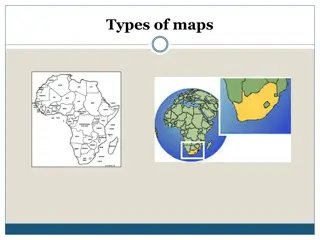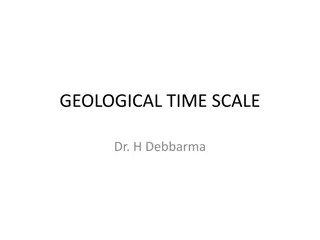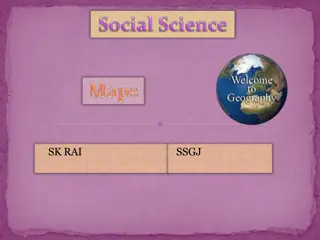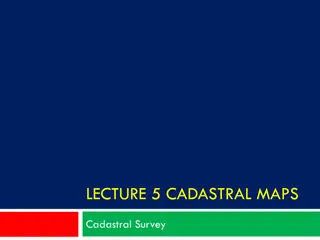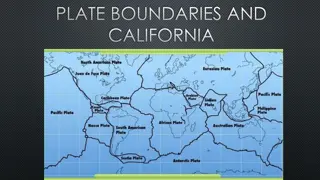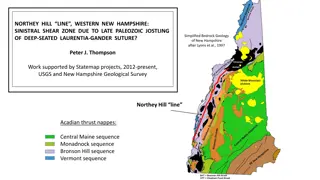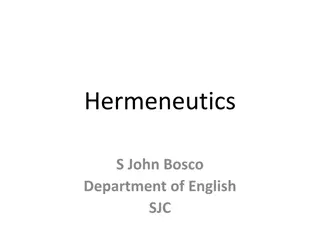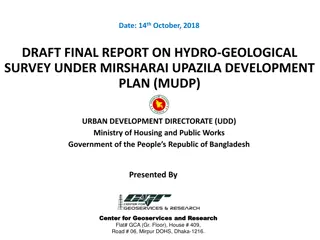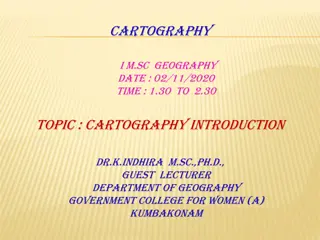Understanding Geological Maps: Interpretation and Description
Training in geological map interpretation aims to accurately identify features depicted on maps through careful examination of geological information. The description of a geological map involves a chronological synthesis of geological data, analysis of the geology of an area focusing on relief, succession, structure, igneous activity, economic geology, and geological history. Thinking in three dimensions is crucial for interpreting geological maps effectively.
Download Presentation

Please find below an Image/Link to download the presentation.
The content on the website is provided AS IS for your information and personal use only. It may not be sold, licensed, or shared on other websites without obtaining consent from the author. Download presentation by click this link. If you encounter any issues during the download, it is possible that the publisher has removed the file from their server.
E N D
Presentation Transcript
DESCRIPTION OF A GEOLOGICAL MAP
DESCRIPTION OF A GEOLOGICAL MAP Preamble The main objective of training in geological map interpretation is to identify as accurate as possible with the aid of diagrams and sections the features depicted on maps. The geologist must consider several possibilities and choose the most plausible explanation for a set of observations. The initial step therefore is to carefully examine the map for all available geological information. The key or legend gives information on the aerial distribution and quite often, the age of the different rock types. The key to success in interpreting geological maps is the ability to think in three dimensions. There are two main aspects to the description of a geological map:
Geological History Careful chronological synthesis of the geological data or information acquired from the map should be undertaken. The older bed should be described first by noting the peculiarity of its outcrop(s). Ages and types of folding, faulting and igneous activities should also be given a place. A recommended procedure particularly when describing maps with unconformities is to group the rocks into series using the unconformities as these represent stratigraphical breaks. The account continues systematically from the oldest to the youngest bed. It usually ends with the erosion of the superficial deposits and land forms record the latest geological event in any given area.
Geology of an area. It is convenient to break the account of geology of an area into several sections in order to fully describe it. Some of these sections are given below: (i) Introduction The introduction should reflect the relief features such as the drainage patterns, values of the contours and the spacing, etc. Peculiarity of outcrops should be noted and related where possible to the relief and/or structure. The general structural pattern and the trend of the main structural features should be deduced from the outcrop pattern. (ii) Succession It is common to present this section in a tabular or diagrammatic summary. The true thickness where known is written in front of each of the strata. The positions of the igneous and metamorphic rocks and unconformities* are accurately indicated. The superficial deposits should also be put in the correct places.
(iii) Structure Structural features such as unconformities*, folds and its nature, type(s) of fault, amount and direction of throw and the dip of the fault plane. Age(s) of period(s) of earth movement should be indicated. (iv) Igneous Activity Igneous and metamorphic rocks should be carefully studied (if present) in terms of their nature and distribution. Detail description should include dating it relative to the surrounding country rocks. (v) Economic Geology Indication of mines, quarries etc should be recorded here. (vi) Geological history In this section, the geological history of the area is set out in chronological order beginning with the oldest bed. Unconformities* - Discordant relationship between strata of some geological age with older rocks lying beneath.
SEDIMENTARY ROCKS Beds and Bedding Planes Rocks are being constantly subjected to weathering. The products of weathering are transported by the agents of erosion namely, running water, wind, waves, currents, glaciers, plant and animals and deposited in lakes, deserts, oceans, etc. Most sediments are deposited in a nearly horizontal position. If the agents transporting sediments from the site of weathering to that of deposition is strong enough, it may succeed in separating the fine particles from the coarse ones. This process is known as sorting. When the agent is weak, only fine sediments will be transported. Renewed energy will bring in coarse particles. Sediments are deposited layer by layer resulting in the formation of a layered structure otherwise known as bedding or stratification.
When several layers have been formed, the lower or older beds become compacted and form distinct beds or strata. These are sedimentary rocks. They may differ from one another in texture, mineral composition or both. The surface separating a bed rock from the next is known as bedding plane. This is a planar structure. There are other types of planar structures namely cleavages*, e.g. of slates and phyllites, schistosity and gneissic banding, faults, axial planes of folds etc. A bed of rock is bounded by two bedding surfaces and each bedding surface is common to two beds of rock except for the top and bottom beds in a sequence. On geological maps, formation boundaries or bedding planes are represented by continuous curves when observed in the field. Inferred boundaries are usually drawn in discontinuous curves. Cleavages* - Breaking along parallel surfaces.
Horizontal strata The boundary between any two distinct beds is often defined by an abrupt change in lithological character. The law of superposition in geology states that in any undisturbed stratified sequence, each bed is younger than the underlying bed. In Fig. 3.1(a-b), the bedding plane between the limestone and shale is horizontal. It is at the same height above the sea level which agrees with the definition of a contour. Therefore the bedding plane of a horizontal bed of rock is parallel to the contour. Similarly, the shale/sandstone and sandstone/conglomerate boundaries run parallel to the contours. They are therefore horizontal. The first step is to draw the topographical profile which can be drawn by the method already described. The geological boundaries can be inserted in a similar way by placing the strip of paper once again along the section line.
Mark the point at which the line of section cuts the perpendicular lines from the base line to touch the profile. From the points on the profile draw horizontal lines as illustrated. On the geological map, you will notice that the sandstone/conglomerate boundary coincides with the 100 m contour line. Therefore in the section, the portion below the 100 m line is the conglomerate. On the map, once again the shale/sandstone boundary coincides with the 250 m contour line. The boundary is inserted along this line in the section. The bed above is the shale while the bed below is the sandstone. Similarly the limestone bed lies above the 350 m line in the section.
A 400 300 200 100 100 100 300 B Fig. 3.1(a): Horizontal Strata
A B 350 250 100 Scale: 1 cm = 100 m. Fig. 3.1(b): Cross-section
Inclined and Vertical Strata Inclined Strata: when a bed is tilted, it is said to dip. The dip can be gentle or steep. The angle of dip otherwise referred to as the true dip angle is the angle between the horizontal and the line of greatest slope on the inclined surface. The altitude of an inclined bed is described in terms of strike and dip (Fig 3.2). A strike is defined as the compass direction of a horizontal line on a bedding plane. The true dip direction is perpendicular to the direction of strike. Any direction other than the true dip direction is the apparent dip direction. The strike and dip of a geological surface such as a bedding plane are measured with a compass-clinometer.
Strike Dip Dip Bedding Plane Strike Water Surface Fig. 3.2: A bedding plane showing Dip and Strike.
To measure the strike of a bedding plane, the compass-clinometer is placed on the plane (Fig. 3.3) and held level. This position is achieved when the compass needle shakes freely. The edge of the compass is then pressed against the plane. This is the strike direction. The strike reading is given by the compass needle. To measure the dip of the plane, the instrument is oriented at right angles to the strike. The angle of dip is recorded by the clinometer s needle. Fig. 3.3: Compass Clinometers
In reality, the thickness of a bed varies from place to place. An isopachyte is a line of constant thickness between two given horizon. Isopachyte or isopach maps are used to show the varying thickness of each chronostratigraphical unit deposited during a particular interval of geological time. When combined with the lithofacies maps which show the variation in the lithological characters of chronostratigraphical units throughout a given region, the paleogeography of the region can be elucidated. Vertical Strata When an inclined bed is pushed by the internal forces within the earth s crust, it may approach a horizontal or vertical position. When it is vertical, the angle of dip is 90o.




